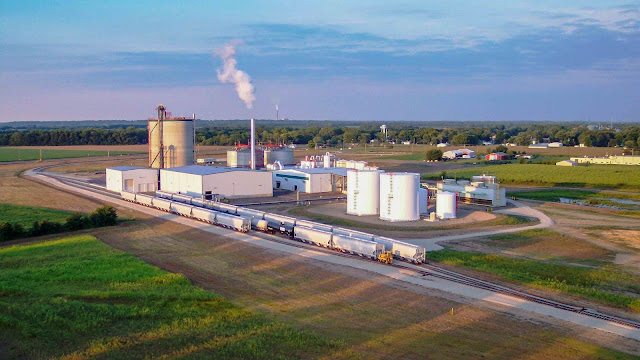U.S. Ethanol: A Growing Renewable Fuel
 |
| U.S. Ethanol |
The United States has seen
substantial growth in ethanol production and use over the past two decades.
Ethanol, a renewable biofuel produced primarily from corn, has become an
important component of the country's transportation fuel system. Let's take a
deeper look at where the U.S. ethanol industry has been and where it is headed.
A Brief History
The origins of the ethanol industry in the U.S. can be traced back to the 1970s
oil crisis. That's when Congress first recognized the need to develop domestic
renewable fuels to reduce the country's dependence on imported petroleum. In
1978, the country produced its first commercial ethanol plant. Through the
1980s and 1990s, ethanol production gradually increased, supported by a handful
of federal and state incentives. However, it wasn't until the 2000s that the
industry really began to take off. In 2005, Congress passed the Renewable Fuel
Standard (RFS), requiring increasing amounts of renewable fuels like ethanol to
be blended into gasoline annually. This long-term policy goal spurred billions
of dollars in new investment and sent ethanol production skyrocketing.
Corn Ethanol Dominates
With its vast corn crop, the U.S. has focused its renewable fuel efforts
predominantly on corn ethanol. Over 95% of domestic ethanol production comes
from corn kernel fermentation. Corn ethanol benefits from the existing
infrastructure built up around corn farming and transport over the past
century. Massive ethanol plants capable of producing over 100 million gallons
annually were constructed across the rural Midwest and Great Plains, near
abundant corn supplies. Today, over 200 ethanol biorefineries dot the landscape
of major corn-growing states like Iowa, Nebraska, and Illinois, employing over
400,000 Americans. Through advanced technologies, these biorefineries can now
produce ethanol, distiller grains for livestock feed, and other co-products
from every kernel of corn.
Rising Production and Blending Levels
Spurred by the RFS, U.S.
Ethanol production skyrocketed from 3.9 billion gallons in 2005 to a
record 15.8 billion gallons in 2020. Similarly, the amount blended into the
nation's fuel supply has also risen dramatically. E10, or gasoline containing
10% ethanol, is now standard at most pumps across the country. Some states like
Nebraska and Kansas have even adopted E15 or E25 fuel standards, pushing
ethanol blending capacity to its practical limit in standard vehicle engines.
As blending infrastructure expands nationwide, experts forecast that ethanol
will continue to displace tens of millions of barrels of imported oil each
year. Today, ethanol provides about 10% of the nation's fuel transport needs.
Controversies Remain
Despite its advantages, corn ethanol has remained a controversial issue.
Skeptics argue that it provides little, if any, greenhouse gas emissions
reduction benefits compared to gasoline. Others point to its role in distorting
commodity crop markets and displacing traditional food uses of corn. Government
mandates like the RFS are also criticized for picking winners and losers,
propping up corn interests at taxpayers' expense. On the flip side, ethanol
supporters counter that advanced technologies have significantly improved its
carbon footprint, and that it reduces oil dependence while creating jobs in
rural communities. The debate around corn ethanol's environmental impacts and
appropriate government support will likely continue for years.
Toward Advanced Ethanol's Promise
With corn supplies limited and its drawbacks acknowledged, the industry is
diversifying. Cellulosic ethanol made from agricultural waste shows great
technical potential but has struggled commercially due to high production
costs. However, as production methods improve and investments pour in,
cellulosic ethanol capacity has grown six-fold since 2018. Pilot plants across
the country are fermenting everything from corncobs and miscanthus grass to
cottonseed shells into alcohol. Similarly, renewable diesel made from soybean
oil is emerging rapidly as an "drop-in" replacement that can use
existing oil infrastructure. Ethanol proponents believe these next-generation
fuels will satisfy environmental concerns while following crop-based ethanol as
major contributors to domestic renewable fuel supplies. If advanced
technologies can deliver on these promises, the U.S. ethanol industry may be
poised for continued long-term growth.
Conclusion
From humble beginnings four decades ago, the U.S. ethanol industry has grown
into a major domestic biofuel sector supported by billions in annual government
incentives. While corn ethanol remains dominant today, entrepreneurs are
pushing innovations to diversify fuel sources and maximize environmental
benefits. If advanced cellulosic, algae, and renewable diesel fuels can scale
up commercially, renewable fuels may continue to displace petroleum on an
ever-larger scale. However, debates over corn ethanol’s impacts ensure the
policy path ahead remains uncertain. One thing is clear - after decades of
development, biofuels have become firmly entrenched in America’s fuel
landscape. The growth potential that has brought the industry this far could
fuel its expansion into the next generation of renewable alternatives.
For
more insights, read- U.S.
Ethanol
Check
more trending articles related to this topic: Sustainable
aviation fuels Market



Comments
Post a Comment